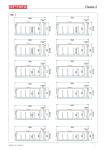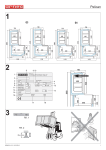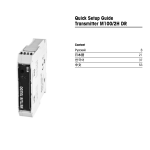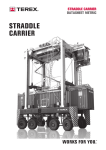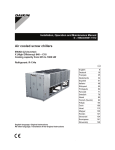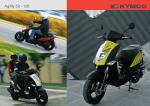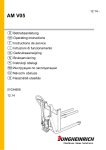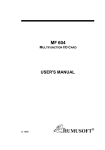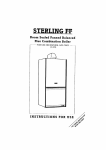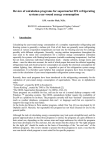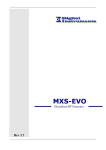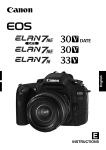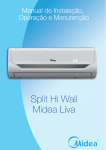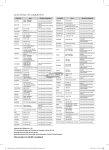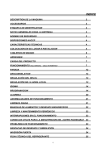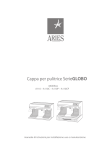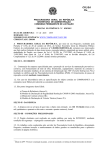Download Mini Toronto
Transcript
Mini Toronto ILLUSTRAZIONI ILLUSTRATIONS ABBILDUNGEN Rif. 1 ILLUSTRATIONS G3 Testata / Head case G3 1433 205 836 1429 935 935 570 570 390 630 552 552 355 345 ÈËËÞÑÒÐÀÖÈÈ 345 ILLUSTRACIONES 1423 G4 Testata / Head case G4 472 472 390 570 570 935 630 935 355 836 1429 425 1433 205 425 831 1424 6 831 1424 1423 10 8 ARNEG S.p.A. VIA VENEZIA 58 - CAMPO SAN MARTINO - PADOVA - ITALY Tel. +39 049 9699333 Fax +39 049 9699444 - [email protected] 1 Rif. 2 2 3 5 9 11 12 14 CODICE ITEM 16 COMMESSA W.SCHED V SBRINAMENTO DEFROSTING SUPERF.ESP. DISPLAY AREA MATRICOLA S/N Hz ILLUMINAZIONE LIGHTING W IP 4 7 15 MASSA WEIGHT kg 13 W W A m2 REFRIGERANTE REFRIGERANT CLASSE CLASS ORDINE W.ORD. 17 ANNO YEAR 18 Rif. 3 Rif. 4 05060123 00 30/11/2011 1 Mini Toronto Rif. 5 Rif. 6 Rif. 7 Rif. 9 Rif. 10 Max 25mm 30 cm er Rif. 8 wa t CHEMICALS MAX 30 bar Rif. 11 Rif. 13 ON TI def al./aux PRG mute aux SEL def OP comp fan AL Rif. 12 Rif. 16 Rif. 14 Rif. 15 A Rif. 17 2 Rif. 18 Rif. 19 B Rif. 20 05060123 00 30/11/2011 Mini Toronto Rif. 21 Rif. 22 Rif. 23 H2O 937,5 937,5 1875 1875 3750 1875 H2O H2O R404A 392 392 R404A H2O 392 R404A 392 R404A 1250 1250 2500 713,5 713,5 1290 Rif. 24 TESTATA - HEAD CASE 05060123 00 30/11/2011 3 Mini Toronto Rif.25 3DUW$ $ 6287 % 6,1 6'() 3DUW% 6'() 4 6,1 Quadro elettrico 6287 05060123 00 30/11/2011 Mini Toronto Rif.26 1 b a 2 3 4 NO OK Rif.27 OK ȂǹȋNJP2 NO ȂǹȋNJP2 carico uniformemente distribuito evenly distributed load belastung gleichmässig verteilt charge uniformément répartie carga distribuida uniformemente равномерно распределенная нагрузка 05060123 00 30/11/2011 5 6 B A 1 1 1 A CON LUCE/WITH LIGHT % 3DUW% 3DUW$ $ Mini Toronto Rif.28 05060123 00 30/11/2011 05060123 00 30/11/2011 $ 3DUW$ Rif.29 Mini Toronto 7 05060123 00 30/11/2011 PE PE INTERR.LUCI LIGHT SWITCH POWER 1 PE PE MESSA A TERRA PER CAVI CALDI A SINGOLO ISOLAMENTO EARTH CONNECTION FOR SINGLE INSULATED HEATERS 2 3 N 1 N 1 N 1 N CAVO CALDO SUPERIORE VETRATA UPPER GLASS HEATER 4 1 ALIMENTAZIONE CAVI CALDI HEATERS SUPPLY S +=ALIM./SUPPLY S=SEGNALE/SIGNAL R + S +=ALIM./SUPPLY -=COMUNE/COMMON S=SEGNALE/SIGNAL TRASDUTTORE RAZIOMETRICO RATIOMETRIC TRANSDUCER PE I CONNETTORI POWER 4 E POWER 5 NON SONO UTILIZZATI NEL CASO DI ISOLE SENZA ILLUMINAZIONE E VASCHE COMBINATI BT 2E. POWER 4 AND POWER 5 CONNECTORS ARE NOT USED IN CASE OF ISLANDS WITHOUT LIGHTING AND TANK OF COMBINED LT 2E. R3 PE R4 COLLEGAMENTO ILLUMINAZIONE/LIGHTING CONNECTION R2 PE R1 PE RESISTENZA SBRINAMENTO DEFROST HEATER PE N R1 PE N R2 PE N R3 PE N R4 CONNECTION FOR CABINET WITH 2 EV. (MALMOE3) POWER 3 RESISTENZA SBRINAMENTO DEFROST HEATER RESISTENZA SBRINAMENTO DEFROST HEATER RESISTENZA SBRINAMENTO DEFROST HEATER PE N R1 PE N R2 PE N R3 PE N R4 CONNECT R1 EVAPORATOR 1 PARALLEL R1 EVAPORATOR 2. SIMILARLY FOR THE OTHER HEATERS (R2 AND R3). PE 5A 5B ALIMENTAZIONE VENTIL. EVAP. EVAPORATOR FANS SYPPLY 2 M PE 5A 5B PE N ALIMENTAZIONE VALVOLA VALVE SUPPLY 2 COLLEGAMENTO PER BANCHI A 2 EV. (MALMOE3) POWER 2 VENTILATORI EVAPORATORE EVAPORATOR FANS VALVOLA SOLENOIDE SOLENOID VALVE PE N COLLEGARE LA R1 DELL'EVAPORATORE 1 IN PARALLELO CON LA RESISTENZA R1 DELL'EVAPORATORE 2. ANALOGAMENTE PER LE ALTRE RESISTENZE (R2 E R3). 1 N mA + 1 N 1 N TRASDUTTORE DI PRESSIONE 4-20 mA PRESSURE TRANSDUCER 4-20 mA 1 N CAVO CALDO NASETTO DI MANDATA AIRFLOW HEAD HEATER 1 CAVO CALDO INFERIORE VETRATA LOWER GLASS HEATER CAVO CALDO SPALLA/ASPIRAZIONE SIDE WALL/AIR SUCTION HEATER EEV 8 ALIMENTAZIONE RESIST. SBRIN. DEFROST HEATER SUPPLY POWER 4 3 2 1 4 3 2 4 3 1 2 CON CAVO COLORATO: BLU(1)-MARRONE(2)-GRIGIO(3)-NERO(4) 1 WITH COLORED CABLE BLUE(1)-BROWN(2)-GRAY(3)-BLACK(4) ALIMENTAZIONE ILLUMIN. LIGHTING SUPPLY 4 5 5 01 02 POWER 5 I I 2 PE N PE N 1 CAVO DI COLLEGAMENTO SOVRASTRUTTURA ILLUMINATA UPPER LIGHTING CABLE PROBES 1 1 CAVO DI COLLEGAMENTO CORRIMANO/MANDATA 2 2 2 Sout 4 4 3 3 6 5 SCHEMA ILLUMINAZIONE ISOLE BT: D5A15925 WIRING DIAGRAM OF LIGHTING FOR ISLANDS LT: D5A15925 6 5 Sdef SONDA FINE SBRINAM. END DEFROST PROBE 1 SONDA MANDATA ARIA AIR OUTLET PROBE Sin SONDA RIPRESA ARIA AIR INLET PROBE 1 LIGHTING RAIL/ LIGHTING AIR OUTLET CABLE G.VERDE/Y.GREEN 1 BLU/BLUE 2 MARRONE/BROWN Ssh SONDA SURRISCALDAMENTO SUPERHEATING PROBE PROBES 2 1 1 2 3 3 4 4 4 + - 3 2 TRASDUTTORE DI PRESSIONE PRESSURE TRANSDUCER 2 Ssh Sev 1 SONDA SURRISCALDAMENTO SUPERHEATING PROBE SONDA INGRESSO REFRIGERANTE REFRIGERANT INLET PROBE 5 S 5 5 L N 1 2 NON UTILIZZATI NOT USED 5 6 Schema elettrico standard / standard wiring diagrams Rif.30 schema elettrico Mini Toronto 05060123 00 30/11/2011 2,85 1012 565 TISE-SW TIO-001 4 x 6.5 2760 2,14 759 424 TISE-SW TIO-000 3 x 6.5 2070 4200 6 x 6.5 TISE-SW TIO-002 848 1518 4,28 3750 1875 990 2 x 6.5 TISE-SW TIO-000 264 316 0,81 20 bar R404A 2070 3 x 6.5 TISE-SW TIO-000 441 759 2,14 Max +32°C / Min -35°C -18°C / -25°C TST 2760 4 x 6.5 TISE-SW TIO-001 588 1012 2,85 2500 4200 6 x 6.5 TISE-SW TIO-002 881 1518 4,28 3750 Minitoronto G4 990 2 x 6.5 TISE-SW TIO-000 275 316 0,81 TST < 60 Automatico/Elettrico - Automatic/Electrical - Automatisch/Elektrisch - Automatique/Electrique Automático/Eléctrico Ⱥɜɬɨɦɚɬɢɱɟɫɤɢɟɗɥɟɤɬɪɢɱɟɫɤɨɟ 2500 1875 Minitoronto G3 Dati tecnici Technical data Technische Daten Données techniques Datos Técnicos Ɍɟɯɧɢɱɟɫɤɢɟ ɯɚɪɚɤɬɟɪɢɫɬɢɤɢ Contenuto modificabile senza preavviso, Content that could be change without notice, Inhalt Veränderbar ohne Vorankündigung, Contenu modifiable sans préavis, Contenido modificable sin previo aviso, ɋɨɞɟɪɠɚɧɢɟɢɡɦɟɧɹɟɬɫɹɛɟɡɩɪɟɞɭɩɪɟɠɞɟɧɢɹ Lunghezza senza spalle, Length without ends, Länge ohne Seiten, mm Longeur sans joues, Longitud sin laterales, Ⱦɥɢɧɚɛɟɡɛɨɤɨɜɢɧ Temp. di esercizio, Working temperature, Betriebstemperatur, °C Temp. de fonctionnement, Temperatura de trabajo, Ɋɚɛɨɱɚɹɬɟɦɩɟɪɚɬɭɪɚ Temperature ammissibili, Allowed temperature, Zulässige Temperaturen °C Températures admissibles, Temperaturas admitidas, Ⱦɨɩɭɫɬɢɦɵɟɬɟɦɩɟɪɚɬɭɪɵ- (Ts) 97/23 CE Superficie di esposizione orizzontale, Horizontal display surface, Gesamte Ausstellefläche, Surface d m2 ’exposition horizontale , Superficie de exposición de apoyo, Ƚɨɪɢɡɨɧɬɚɥɶɧɚɹɩɥɨɳɚɞɶɷɤɫɩɨɡɢɰɢɢ Volume netto, Net volume, Netto inhalt, Volume net, Volumen neto, dm 3 ɑɢɫɬɵɣɜɟɫ Potenza frigorifera, Refrigeration Power, Kühlleistung, Puissance frigorifique Potencia frigorígena, W ɏɨɥɨɞɢɥɶɧɚɹɦɨɳɧɨɫɬɶ Refrigerante, Refrigerant, Kühlmittel, Réfrigérant, Refrigerante, ɏɥɚɞɚɝɟɧɬ Massima pressione ammissibile, Max allowed pressure, Maximal zulässiger Druck, Pression maximale bar admissible, Máxima presión admitida, Ɇɚɤɫɢɦɚɥɶɧɨɞɨɩɭɫɬɢɦɨɟ Ⱦɚɜɥɟɧɢɟ- (Ps) 97/23 CE Valvola espansione, Expansion Valve, Expansion-Ventil, Valve d’expansion, Válvula de expansión, Ɋɚɫɲɢɪɢɬɟɥɶɧɵɣɤɥɚɩɚɧ n° x W Ventilatori, Fans, Gebläse, Ventilateurs, Ventiladores, ȼɟɧɬɢɥɹɬɨɪɵ Resistenza di sbrinamento, Defrost heater, Abtauwiderstand,Resistance de dégivrage, Resistencias de W descongelation, Ɇɨɳɧɨɫɬɶɨɬɬɚɢɜɚɧɢɹ237,21$/ Tipo di sbrinamento, Defrosting type, Abtautyp, Type de dégivrage, Tipo descongelation, Ɍɢɩ ɨɬɬɚɢɜɚɧɢɹ db (A) Livello di rumorosità , Noise level, Schallpegel, Niveau de bruit, Nivel de ruido, ɍɪɨɜɟɧɶɲɭɦɚ Modello, Model, Modell, Modele, Modelo, Ɇɨɞɟɥɶ . . . . . . Mini Toronto Dati Tecnici, Technical Data, Technische Daten, Données techniques, Datos Técnicos, Ɍɟɯɧɢɱɟɫɤɢɟ ɯɚɪɚɤɬɟɪɢɫɬɢɤɢ 9 Mini Toronto English Installation and User Manual CONTENTS ILLUSTRATIONS................................................................................................................. Technical data...................................................................................................................... 1 - Informational symbols..................................................................................................... 2 - Prohibitions and prescriptions......................................................................................... 3 - Purpose of the Manual/Field of Application - Interested Parties..................................... 4 - Presentation - Proper use (Rif. 1) ................................................................................... 5 - Norms and certifications ................................................................................................. 6 - Identification - Rating plate data (Rif. 2) ......................................................................... 7 - Transport - specialised technician - ................................................................................ 8 - Storage ........................................................................................................................... 9 - Receipt, unpacking, initial cleaning - qualified operator - ............................................... 9 - Receipt, unpacking, initial cleaning - qualified operator - ............................................... 9 - Receipt, unpacking, initial cleaning - qualified operator - ............................................... 12 - Electrical connection - specialised technician - ............................................................ 12 - Electrical connection - specialised technician - ............................................................ 13 - Probe placement (Rif. 25) - specialised technician - .................................................... 14 - Start-up, temperature control and adjustment - specialised technician -...................... 15 - Filling the unit - qualified operator - .............................................................................. 15_1 - Loading of cabinets for ice cream and frozen foods ............................................ 16 - Defrosting and water discharge (Rif. 23) ...................................................................... 16_1 - Water discharge: .................................................................................................. 17 - Lighting ......................................................................................................................... 18 - Superstructure (Rif. 26) ................................................................................................ 19 - Anti-condensation and fog resistance........................................................................... 20 - Maintenance and cleaning- qualified operator -............................................................ 20_1 - Cleaning of external parts (Daily/Weekly) ............................................................ 20_2 - Cleaning of internal parts (Monthly) ..................................................................... 20_3 - Cleaning the sliding doors.................................................................................... 20_4 - Cleaning the "honeycomb" (Rif. 16) ..................................................................... 20_5 - Cleaning stainless steel parts .............................................................................. 20_6 - Inspection parts.................................................................................................... 21 - Dismantling the unit - specialised technician -.............................................................. 05060123 00 30/11/2011 1 9 24 24 25 26 27 27 28 28 28 28 28 30 30 31 31 31 31 32 32 32 32 32 33 33 33 34 34 34 34 34 23 Mini Toronto English 1. Informational symbols Before reading the manual, take a moment to learn the symbols: This symbol indicates dangers and actions that should always be avoided during use, maintenance or in any situation, as they could cause serious injury or death. This symbol indicates instructions, rules, advice, and communications that each person assigned to use the unit (in reference to their individual responsibilities) must respect during the entire time they are using the unit (installation, use, maintenance, dismantling, etc.). 2. Prohibitions and prescriptions The Installation and User Manual should be read carefully so that the operator, in the event of malfunction, is able to provide precise information to Technical Support by telephone. Before contacting Technical Support, first check the following: XBefore carrying out any maintenance work on the refrigerator unit, please ensure that the electrical supply is disconnected. XThese units are designed for use only in closed environments XTake great care over all working manoeuvres (loading, unloading, cleaning, counter service, maintenance, etc.) and always apply maximum diligence, using appropriate protective equipment for the various operations. XThe refrigeration unit is intended to maintain the temperature of the goods displayed and not to reduce it. Foodstuffs should only be placed inside if they are already cooled to their respective conservation temperatures. As such, products that have been warmed up must not be placed in the unit. XThe units are designed and built to store and display only fresh and frozen foods, ice creams, cooked and pre-cooked items (canteens). Do not introduce any type of goods other than those specified such as pharmaceutical products, fishing bait, etc. XCheck that the temperature and relative humidity values do not exceed specifications. For this reason it is essential that the air-conditioning, ventilation, and heating systems in the sales point are kept at maximum efficiency. XLimit airflow speed to less than 0.2 m/s in the proximity of the unit's openings. It is particularly important to avoid air currents and the air conditioning system's air delivery openings being aimed towards the opening of the units. XOnly introduce merchandise into the unit that has already been cooled to its normal cold-chain temperature. XMake sure that the unit is always able to maintain said temperature. XRespect the load limit. Do not overload the cabinet. XRotate food products by loading the cabinet in such a way that the goods displayed for longest are sold before new arrivals. XWith the help of a specialised technician, eliminate any problems found (loose screws, blown bulbs, etc.). XCheck the flow of defrosted water (unblock drains, clean any filters, check siphons, etc.). 24 05060123 00 30/11/2011 Mini Toronto English XDispose of defrosted water or water used for washing through the drains or purification system in accordance with current legislation as this may come into contact with pollutants due to the nature of the product, any residues, accidental breakages of casing containing liquids and the use of non-permitted detergents. XCheck for any anomalous condensation. If found, immediately contact your refrigeration technician. XCarry out all preventive maintenance operations punctually. XDO NOT remove protective covers or panels that require the use of tools to be removed. More specifically, do not remove the electrical panel cover. These operations must always be carried out by specialised technicians. XDO NOT obstruct the air intake openings. XExposed merchandise should not be in direct sunlight. Danger: alteration of merchandise. XLimit the temperature of radiating surfaces located in the sales point, e.g. insulating ceilings. XDO NOT use spotlights with incandescent bulbs aimed directly at the unit. Danger: overheating the merchandise. XIN THE CASE OF A GAS LEAK OR FIRE: Do not place your head inside the area in which the unit is located if it is not appropriately ventilated. Disconnect the unit by means of the general switch upstream of the appliance. DO NOT USE WATER TO PUT OUT THE FLAMES, USE ONLY DRY EXTINGUISHERS. ANY OTHER USE NOT EXPLICITLY INDICATED IN THIS MANUAL IS TO BE CONSIDERED DANGEROUS. THE MANUFACTURER SHALL NOT BE HELD RESPONSIBLE FOR ANY DAMAGES THAT MAY OCCUR FROM IMPROPER, ERRONEOUS, OR UNREASONABLE USE. USEFUL TELEPHONE NUMBERS: SWITCHBOARD +39 0499699333 - FAX +39 9699444 - CALL CENTRE 848 800225 3. Purpose of the Manual/Field of Application - Interested Parties This instruction manual contains a description of the Mini Toronto line of refrigeration units, manufactured by ARNEG Spa. The following information provides instructions with regard to: Xusing the cabinet Xtechnical specifications Xinstallation and assembly Xoperator information Xmaintenance operations Xsafety information The manual should be considered part of the unit and must be kept for its entire working life. The manufacturer is relieved from all liability in the following situations: Ximproper use Xincorrect installation - not completed in accordance with the regulations specified Xpower supply faults Xserious lack of maintenance Xunauthorised alterations and operations Xuse of non-original spare parts Xpartial or complete lack of compliance with the instructions. 05060123 00 30/11/2011 25 Mini Toronto English This manual must be the responsibility of an assigned person, stored in an appropriate location, known to all assigned workers and maintenance employees, so that it can be consulted whenever needed. In the event of transfer to third parties, it must be delivered to the new user or owner, duly informing the suppliers in a timely manner. If lost or damaged, please contact the supplier. This manual is intended for: QUALIFIED OPERATORS: qualified individuals, instructed in the use, adjustment, cleaning, and maintenance of the unit. SPECIALISED TECHNICIANS: trained technicians, authorised to carry out extraordinary maintenance, repair, replacement, and tuning operations who are aware of the risks they are exposed to in carrying out said operations and able to adopt all the measures appropriate to protect themselves and others, minimising damage with respect to the risks that these operators have. Where not specified, the section is applicable to both types of users The contents of this manual represent the current technical and technological status used in manufacturing the unit, and valid at the time the unit in question was sold. Therefore, it cannot be considered obsolete in the case of later updates connected to new regulations or knowledge. Anyone using this unit must read this manual. 4. Presentation - Proper use (Rif. 1) The unit is intended for use by qualified personnel that have been instructed and trained by their employer with regards to use and the risks that come with it. The Mini Toronto line of closed refrigerated islands are appropriate for preserving and self service sales of frozen foods and ice creams. XElectrical appliances can be dangerous to health. Current laws and regulations must be respected during installation and use. XRemoving protective covers or panels requiring tools for removal is prohibited. DO NOT allow the following types of people to use the unit: Xchildren Xpersons unable to use the unit safely without supervision or instructions Xdisabled individuals Xemployees who are not sober or are under the effect of narcotics XCarefully read the manual before use and instruct assigned employees with regards to the various operations (transport, installation, maintenance, etc.), in line with their assigned responsibilities, and in accordance with the instructions contained in the manual. XThe Client or employer assumes full responsibility regarding the qualification and mental and/or physical state of the employees assigned to use and maintain the machine. XThis documentation CANNOT in any way serve as a substitute for a lack of education or intelligence in the personnel that interacts with the equipment. XThe units are designed and built to store and display only fresh and frozen foods, ice creams, cooked and pre-cooked items (canteens). Do not introduce any type of goods other than those specified such as pharmaceutical products, fishing bait, etc. 26 05060123 00 30/11/2011 Mini Toronto English 5. Norms and certifications All the refrigeration unit models described in the usage manual for the Mini Toronto series meet the essential requirements for safety, health, and protection required by the following European directives and laws: XMachines Directive 2006/42 EC; applied EN norms: EN ISO 14121:2007; EN ISO 12100-1:2005; EN ISO 121002:2003 XElectromagnetic Compatibility Directive 2004/108/EC; applied EN norms: EN 61000-3-2:2006; EN 61000-3-12:2005; EN 55014-1:2006; EN 55014-2:1997; XLow Voltage Directive 2006/95/EC; applied EN norms: EN 60335-1:2008; EN 60335-2-89 :2002/A2:2007 European RegulationEC-1935/2004 on materials and articles intended to come into contact with food - standards applied: EN 1672-2 They are excluded from the field of application of Directive EEC 97/23 (PED) on the basisof that specified by Article 3 paragraph 3 of the Directive. In the case that the original copy of the Declaration of Product Conformity provided with the product is lost, it is possible to download a copy by completing the form found at the following website: http://www.arneg.it/conformity The performance of these refrigeration units has been determined using tests carried out in accordance with UNI EN ISO 23953-2: 2006 regulations, in the environmental conditions corresponding to climate class 3 (25 °C , 60% R.H.) Environmental climatic classes according to UNI EN ISO 23953 - 2 Climatic class Temp. dry bulb Relative humidity Dew point 1 16°C 80% 12°C 2 22°C 65% 15°C 3 25°C 60% 17°C 4 30°C 55% 20°C 5 40°C 40% 24°C 6 27°C 70% 21°C 6. Identification - Rating plate data (Rif. 2) A serial plate is affixed behind the unit, stating all characteristic data: 1) Manufacturer's name and address 2) Unit name and length 3) Unit code 4) Unit serial number 5) Voltage supply 6) Supply frequency 7) Current used when operating 8) Electrical power used when operating during refrigeration phase (fans+hot cables+lighting) 9) Electrical power used when operating during defrost phase (armoured resistances+hot cables+fans+lighting) 10) Lighting power (where applicable) 11) Net display surface 12) Type of refrigerant fluid with which the system functions 13) Mass of refrigerant gas with which each system has been loaded (only for units with built-in motor) 14) Environmental climatic class and temperature of reference 15) Humidity protection class 16) Unit manufacturing order number 05060123 00 30/11/2011 27 Mini Toronto English 17) Unit production order number 18) Unit year of production In the case of a request for technical assistance, please provide the following information: Xproduct name (Rif. 2 - 2); serial number (Rif. 2 - 4); work order number (Rif. 2 - 16). 7. Transport - specialised technician Loading/unloading operations must always be carried out by qualified personnel able to check weights, exact lifting points, and the most appropriate means of transport, both in terms of safety and capacity. The cabinets are supplied on a wooden platform frame to the base for movement with forklift trucks. Use a manual or electrical forklift truck that is suitable for moving the cabinet in question. It must have a nominal capacity of at least 1,000 kg. XAlways place the forks at the indicated points in order to avoid the risk of overturning, and always completely insert the forks. XNo unnecessary personnel should be present in the lifting area. XBalance the weight of the unit so as to ensure that the load remains in equilibrium (Rif. 3) DO NOT use transportation devices to lift: Xwith a capacity of less than 1,000 kg Xwith inappropriate characteristics or that have been affected by use Xwith non-standard or worn wires or cables Transportation procedures that differ from that indicated are prohibited. 8. Storage XDO NOT store the units in uncovered areas where they are subject to weathering and direct sunlight. Exposure to ultraviolet rays leads to permanent deformation of the plastic materials and damages the unit’s components. XThe units must be stored in closed areas, at a temperature between -25°C and +55°C and with relative humidity between 30% and 90%. XBefore storing, check that the packaging is intact and that it doesn't show any defects that could compromise the preservation of the units. 9. Receipt, unpacking, initial cleaning - qualified operator Before starting any unpacking operations, take all possible precautions to avoid injury to the operator. The unit may be provided packaged, specifically: XWith a wooden frame fixed to the base and a nylon covering held in place by straps (standard) (Rif. 5). XWith cardboard covering (upon request) (Rif. 6). XWith a wooden cage (upon request) (Rif. 7). Upon acceptance of the cabinet: XEnsure that the packaging is intact and there is no obvious damage; XUnpack, ensuring that the unit is not damaged; XCheck that all parts of the unit are intact; XIf any damage is found, immediately contact your supplier; XSlowly remove the protective film, taking care to not rip it, in order to avoid leaving traces of glue. If this occurs anyway, they can be removed using appropriate solvents. XClean for the first time using neutral products. Dry with a soft cloth. Do not use any 28 05060123 00 30/11/2011 Mini Toronto English abrasive substances or metal sponges; For correct disposal of the packaging, note that it consists of: Wood - Polystyrene Polythene - PVC - Cardboard. XDO NOT use alcohol to clean the methacrylate parts (Plexiglas). XDuring the unpacking operations, do not leave packaging elements such as nails, wood, staples, nylon, etc. lying around and tools used for the operation such as pliers, scissors, and pincers should not be left in the work area, as they could cause injury or wounds. XThese items should be removed using appropriate methods and placed in the relevant waste collection locations. 10.Installation and environmental conditions - specialised technician Any change to the installation described here must be authorised by ARNEG Spa. To guarantee that the technicians assigned to install the unit work safely, the use of protective tools and clothing required under the safety regulations or laws in effect in the country where it is installed is recommended. In any case, always use appropriate equipment and clothing, such as: safety shoes, protective gloves, a level. For installation, please proceed as follows: Xcarefully inspect the installation area, removing any danger(s) to the operator: Do not position the cabinet: Xin environments with the presence of explosive gaseous substances; Xoutdoors and therefore where there are atmospheric agents; Xnear heat sources (in direct sunlight, near heating systems, incandescent lights, etc.) Xnear air currents (near doors, windows, air-conditioning/heating systems, etc.) exceeding speeds of 0.2 m/sec. Remove the wooden supports on the bottom (used for transportation) and attach the adjustable feet (Rif. 8) positioning them so that the unit is horizontal, using a level (Rif. 9) to check the alignment. Before connecting the unit to the electricity, ensure that the plate data corresponds to the characteristics of the electrical system to which it is to be connected. For the unit to function properly, the temperature and relative humidity must not exceed the limits for climate class 3 (+25°C; R.H. 60%) as established in EN-ISO 23953 - 2 regulations, under which the unit was tested. XDo not move the unit by putting stress on the side glass surfaces to avoid deforming the support brackets (Rif. 11) XIf the unit is moved, repeat the levelling process, as improper levelling could compromise the unit's operations. 11.Multiplexing cabinets (Rif. 28- Rif. 29) - specialised technician To multiplex two or more units, proceed as follows: XRemove the sides XPosition the cabinets side by side XRemove the back panels to gain access to the rise holes XConnect the risers and the brackets using the screws and aligning pins provided XReplace the back panels. MULTIPLEX KIT HEAD Ite Pos. Ite Pos. Name Code Name Code 05060123 00 30/11/2011 29 Mini Toronto English 7 6 5 4 3 2 1 Nut E M6 Screw TCEI M6x25 Washer 6x12 ZN Nut E M8 Screw TCEI M8x50 Screw TCEI M8x35 All.plug 4x30 04230400 6 04711098 6 04480103 4 04230600 4 04711041 2 04711040 2 02940652 12 6 5 4 3 2 1 Washer 6x12 ZN Screw TCEI M6x25 Screw TCEI M6x30 Nut E M8 Screw TCEI M8x50 All.plug 4x30 04480103 2 04711098 4 04711068 2 04230600 2 04711041 2 02940652 10 12.Electrical connection - specialised technician BEFORE STARTING ANY OPERATION, FIRST DISCONNECT THE SYSTEM FROM THE POWER SUPPLY! The electrical system must be earthed! XThe systems must be completed in accordance with the regulations that govern construction, installation, use, and maintenance as envisaged under the norms in effect in the country where the unit is installed. XARNEG Spa declines any responsibility with regards to the user and third-parties for damages caused by breakdowns or malfunctioning of the systems installed upstream to the unit and for damages caused by the same due to causes directly attributable to malfunctioning of the electrical system. XThe unit must be protected upstream by an automatic omnipolar thermomagnetic switch with appropriate characteristics. This must also act as a general line disconnection switch. Establishment of the electrical power supply line to the point of where it connects to the unit is the responsibility of the Client. The dimensions of the electrical energy power supply line must be determined in accordance with the electrical power used by the unit (see Technical Specifications). XRemove any metal objects worn: rings, watches, bracelets, earrings, etc. XCheck the electrical diagrams before carrying out the connection XCheck that the voltage supply is as specified on the plate data. XTell the operator where the switch is so that it can be reached quickly in an EMERGENCY. XTo guarantee correct operation, the maximum voltage variation must be between +/6% of the nominal value. XCheck that the power line has appropriate section cables, is protected against overcurrent and dispersions towards earth, in compliance with current standards. XIn the event of an interruption to the electricity supply, check that all store electrical appliances can reboot without causing the overload protections to intervene. If not, alter the system in order to differentiate between the start-up of the various devices. The installer must supply the anchorage devices for all cables in and out of the unit. XAvoid having the casing come into contact with the electrical panel to avoid electric shocks which could cause injury or death. XCheck that the connectors of the illumination (shelves, ceiling, superstructure) are inserted properly and blocked in their sockets so as to avoid disconnection during cleaning and maintenance operations which could lead to electrical shocks harmful to the operator. The automatic thermomagnetic switch should be designed so as not to open the neutral circuit without simultaneously opening the phases. In any case, the opening distance for the contacts must be at least 3mm. 30 05060123 00 30/11/2011 Mini Toronto English 13.Probe placement (Rif. 25) - specialised technician The probes are already placed on the unit and are as follows: Sout Air delivery control probe Sdef End defrost thermostat control probe Sin Air intake control probe XTemperature probe: NTC IP67 L=4000 code 04510153. XThe Sout-Sin probes must be fixed in place using terminals and should not be insulated. XThe Sdef probe must be fixed in place in contact with the fins of the evaporator, between the 3rd and 4th tube (never in correspondence with the fan) using the stainless steel bulb block spring, code 02230021. 14.Start-up, temperature control and adjustment - specialised technician The refrigeration temperature is controlled using the digital thermometer (Rif. 12) or with the electronic control device (OPTIONAL) (Rif. 13). Normally the controller is set in the factory during testing, but it is possible to alter the programming. To do so, please refer to the instructions given by the control device manufacturer. 15.Filling the unit - qualified operator To refill the unit, you must comply with some important rules: Xarrange the goods in such a way that the maximum load line is never exceeded(Rif. 21) - exceeding this limit can interfere with correct air circulation (Rif. 22), causing the temperature of the goods to rise and ice to form on the evaporator; Xthe arrangement of goods, without leaving empty areas, guarantees optimum unit function; Xarrange the goods in a way that does not interfere with the circulation of the refrigerated air(Rif. 22) 2 XThe maximum allowable load for the tank is about 300 kg/m Xleave 4-5 cm. of space between the merchandise and the closures to allow normal circulation of the refrigerated air. XThe refrigeration unit is designed to maintain the temperature of the product displayed and not to lower it. Food products must only be introduced if already cooled to their respective storage temperatures. DO NOT introduce products that have been heated. We recommend first using up the goods that have been stored in the unit the longest, before adding new arrivals (food stock rotation); 15_1.Loading of cabinets for ice cream and frozen foods Xreducing the time for which frozen foods are at environmental humidity and temperature to a minimum to avoid the formation of frost on the boxes, which can, once inside the cabinet, stick together and to the base grille. Xlimit door opening time to 2-3 minutes Xkeep 4-5 cm space between the goods and the air output mouths to allow for 05060123 00 30/11/2011 31 Mini Toronto English normal circulation of refrigerated air. XEntry of warm air into the unit with closures is inevitable. In the case of high humidity, thin layer of frost will form. This will disappear once the doors have been kept closed for 2 hours. XDo not use the sliding doors as a resting plane for goods when loading. The doors have not been designed to support any loads (Rif. 17). XThe refrigeration unit is designed to maintain the temperature of the product displayed and not to lower it. Food products must only be introduced if already cooled to their respective storage temperatures. DO NOT introduce products that have been heated. 16.Defrosting and water discharge (Rif. 23) The Mini Toronto line of refrigeration units is provided with an electrical defrost system, that works by stopping the refrigeration cycle and the use of an armoured resistance inserted in the evaporator). 16_1.Water discharge: To drain the defrost water, you need to: Xhave a floor drain with a slight incline (Rif. 24); Xinstall the provided siphon between the unit drainage pipe and the floor connection. Xhermetically seal the floor drainage area. This will prevent unpleasant odours from forming within the unit, the dispersion of refrigerated air and possible unit malfunctioning due to humidity. Periodically check that the hydraulic connections are still efficient, contacting a qualified installer. 17.Lighting For tank front lighting, a lamp can be installed on the handrail (optional) (Rif. 14). For greater energy savings, the cabinet can be ordered complete with low consumption LED lighting. This allows for: Xreduced lighting consumption Xreduced refrigerator load Xlifespan of lights: over 6 years Xuniform light intensity and colour Ximproved lighting as temperature decreases. 18.Superstructure (Rif. 26) The Mini Toronto line of refrigerator units can be provided with a non-refrigerated superstructure with 1 or 2 shelves. Assemble as follows: Assemble as follows: 1 - Remove the upper snug cover 2 - Place the superstructure frame in the snug, attaching it with the screws provided 3 - Attach the lower covers (a) using the screws provided 4 - Attach the outlet supports (b) using the screws provided XDistribute the load uniformly on both sides XDO NOT load the superstructure on just one side XAvoid overloading the shelves in a disorganised way 2 XThe load must NEVER exceed 90 kg/m (Rif. 27) 19.Anti-condensation and fog resistance To prevent fogging due to condensation, low voltage electrical resistances are used on 32 05060123 00 30/11/2011 Mini Toronto English the parts most subject to this, such as: heat-isolating glass on doors, frames and corners, side facing glass surfaces, etc. 20.Maintenance and cleaning- qualified operator BEFORE CARRYING OUT ANY MAINTENANCE WORK OR CLEANING, FIRST DISCONNECT THE UNIT FROM THE VOLTAGE SUPPLY BY MEANS OF THE GENERAL SWITCH. ALWAYS WEAR X PROTECTIVE GLOVES FOR CLEANING. XDO NOT use hot water on cold glass surfaces, as the glass could shatter and injure the operator. XDO NOT use abrasive products or solvents that could alter the unit surfaces XDO NOT spray water or detergents directly onto the electrical parts of the unit. XDO NOT touch the unit with wet or damp hands or feet XDO NOT use the unit barefoot XDO NOT use alcohol or similar products to clean the methacrylate parts (plexiglass). Xavoid using excessive force during cleaning operations Xavoid chlorine-based detergents such as bleach which may corrode surfaces Xavoid contact with or inhaling vapours emitted from acid, alkaline or ammonia products contained in flooring detergents which may oxidise or corrode stainless steel. Xif internal cleaning is done with water jet cleaners (Rif. 10), use a LOW PRESSURE system (max 30 bar) with an appropriate capacity to remove any residue present. Excessive pressure could damage the surfaces. XDO NOT aim the jet directly at painted or plastic-coated surfaces Xkeep a minimum distance of 30 cm from the surfaces being cleaned (Rif. 10). Xbringing the jet too close to the dirt can cause injury to the operator and contaminate areas that have already been cleaned as well as the environment (Rif. 15). Xavoid wetting fans, lights, electric cables, and all electrical devices in general during cleaning operations. Food products can deteriorate due to microbes and bacteria. Respecting hygiene norms is essential in order to guarantee protection of consumer health, as well as respecting the chain of refrigeration, for which the sales point is the last controllable ring. Cleaning operations must include: 1 - WASHING (removing grease, removal of about 97% of the dirt) 2 - DISINFECTING (using appropriate detergents on the surfaces to remove any pathogenic micro-organisms that might remain after washing). 3 - RINSING 4 - DRYING Cleaning the refrigeration units is carried out as follows: 20_1.Cleaning of external parts (Daily/Weekly) XOn a weekly basis, clean all the external parts of the unit using neutral detergents for domestic use that are compatible with the surfaces to be cleaned, or using warm soapy water, and removing all traces of detergent. XRinse with clean water and dry with a soft cloth. 20_2.Cleaning of internal parts (Monthly) Cleaning the unit's internal parts is done to destroy pathogenic micro-organisms so as to ensure the protection of the merchandise. Before beginning to clean the inside of the unit, it is necessary to: XCompletely remove all merchandise inside; XRemove all the removable parts, such as display plates, grills, etc. XWash with warm water (<40°C) XDisinfect using a detergent with an antibacterial component; XCarefully dry using a soft cloth; 05060123 00 30/11/2011 33 Mini Toronto English XCarefully clean the tank, drip, and water discharge protection grill, eliminating all foreign bodies that may have fallen into the suction grill, lifting the fan plate if necessary. XIf any ice has formed, contact a Qualified Refrigeration Technician for assistance. 20_3.Cleaning the sliding doors Xlift the price holder profile (fig. A) (Rif. 19) Xlift up and slide out the covers (fig. B) (Rif. 20) Xclean as specified for the cleaning of external parts Xreplace the covers Xreposition the cover profile 20_4.Cleaning the "honeycomb" (Rif. 16) XThe honeycomb must be cleaned every 6-8 months, based on sales conditions. XIt can be cleaned using a vacuum cleaner or can be removed and washed using soap and water. XIt must be completely dry before being re-attached. XThe honeycomb must be attached at the same angle. 20_5.Cleaning stainless steel parts Certain situations may lead to the build-up of rust on steel surfaces: Xsteel implements left on surfaces that are damp, lime scaled, not fully rinsed after using chlorine- or ammonia-based detergents, encrusted with pieces of food, salt/ saline solutions, or dry residue from evaporated liquids. Recent marks and rust: Xclean with shampoo or neutral detergents using a sponge or cloth. When done, remove any detergent residue, rinse well, and carefully dry the surfaces. Old marks and rust: Xuse chemical substances for stainless steel that contain 25% nitric acid, or similar substances. Stubborn marks and rust: Xsand or shine using a stainless steel brush. When complete, wash using detergents and dry carefully. This may produce surface scratches due to abrasive cleaning. XAll cleaning operations, including disinfection, rinsing and drying must be performed carefully, removing all traces of water or detergent so as to avoid the proliferation of bacteria that is harmful to health. XParts left to dry with residual detergent of disinfectant may be damaged. Remove any elements such as sponges, clothes, detergent residue, or water from the floor that could cause slipping and accidental falls. 20_6.Inspection parts Once cleaning, disinfection, rinsing, and drying operations have been completed, carefully check that all the parts are perfectly clean and dry and have not been damaged or excessively worn. If necessary, replace them. Attach the elements once perfectly dry and restore the electrical power supply. Once internal operating temperature has been reached, the unit can be loaded with the products to be displayed. 21.Dismantling the unit - specialised technician The unit must be disposed of in accordance with your country’s waste management legislation and in respect of our environment. This product is considered by current legislation as hazardous waste. It must therefore be collected separately and cannot be treated as household waste nor sent to a landfill. Before disposing of the unit, the 34 05060123 00 30/11/2011 Mini Toronto English coolant must be collected and the lubricant oil removed. This product consists of 75% recyclable materials. Materials used in construction: - Iron pipe: lower frame - Copper, Aluminium: refrigeration circuit, electrical system and door frame - Galvanised sheet metal: motor base, lower varnished panels, base structure - Polyurethane foam (H2O): heat insulation - Tempered glass: doors - Wood: side frames foamed tank - PVC: bumper - Plastic laminate: sides XThe user is responsible for delivering the product for disposal to the collection centre specified by the local authorities or manufacturer for the recovery and recycling of materials. XAll these operations , as for transport and waste processing, should be performed by authorised, specialised personnel only. 05060123 00 30/11/2011 35 I Ci riserviamo il diritto di apportare in qualunque momento, le modifiche alle specifiche e ai dati contenuti in questa pubblicazione senza obbligo di avviso preventivo. La presente pubblicazione non può essere riprodotta e/o comunicata a terzi senza preventiva autorizzazione ed è stata approntata per essere utilizzata esclusivamente dai nostri clienti. GB We reserve the right to change our technical specifications without notice. This brochure may not be reproduced, nor its contents disclosed to third parties without arneg’ s consent and it is meant only for use by our customers. D Änderungen der in dieser Broschüre enthaltenen Angaben und Informationen voberhalten. Diese Broschüre darf ohne usere ausdrückliche Genehmigung weder vervielfältigt noch an Dritte weitergegeben werden und sie ist ausschließlich für unsere Kunden bestimmt. F Nous nous réservons le droit d’apporter à tout moment des modification aux spécifiques et aux caractéristiques contenues danse cette publication, sans aucune obligation de préavis de notre part. Cette publication ne peut être reproduite et/ou communiquée â des tiers sans autorisation préalable. Elle a été réalisée pour étre utilisée exclusivement par nos clients. E Nos reservamos el derecho de aportar en cualquier momento las modificaciones a las especificaciones y a los datos contenidos en esta publicació sin ninguna obligación de aiso anticipado.La presente publicación no puede ser reproducida y/o comunicada a terceros sin la previa autorización y ha sido aprontada para ser utilizada exclusivamente por nuestros clientes. RUS Ɇɵ ɨɫɬɚɜɥɹɟɦ ɡɚ ɫɨɛɨɣ ɩɪɚɜɨ ɜɧɨɫɢɬɶ ɜ ɥɸɛɨɣ ɦɨɦɟɧɬ ɢ ɛɟɡ ɩɪɟɞɭɩɪɟɠɞɟɧɢɹ ɢɡɦɟɧɟɧɢɹ ɜ ɫɩɟɰɢɮɢɤɚɰɢɢ ɢ ɞɚɧɧɵɟ ɩɪɢɜɟɞɟɧɧɵɟ ɜ ɧɚɫɬɨɹɳɟɦ ɩɨɫɨɛɢɢ. Ɂɚɩɪɟɳɚɟɫɹ ɜɨɫɩɪɨɢɡɜɨɞɢɬɶ ɢ/ɢɥɢ ɩɟɪɟɞɚɜɚɬɶ ɬɪɟɬɶɢɦ ɥɢɰɚɦ ɛɟɡ ɧɚɲɟɝɨ ɫɨɝɥɚɫɢɹ ɧɚɫɬɨɹɳɭɸ ɩɭɛɥɢɤɚɰɢɸ ɤɨɬɨɪɚɹ ɩɨɞɝɨɬɨɜɥɟɧɚ ɢɫɤɥɸɱɢɬɟɥɶɧɨ ɞɥɹ ɧɚɲɢɯ ɤɥɢɟɧɬɨɜ. ARNEG S.p.A. - Via Venezia, 58 - 35010 Campo San Martino - (PD) Italy - Tel. +39 049 9699333 - Fax +39 049 9699444 - www.arneg.com - Cap. Soc. 43.000.000 i.v. Certified ISO 9001:2008 - ISO 14001:2004 - BS OHSAS 18001:2007 C.F./P. IVA/Reg.Imp. Pd IT 00220200281 - R.E.A. Padova n. 94246 - Meccan. PD009504 - RAEE IT8010000000139























